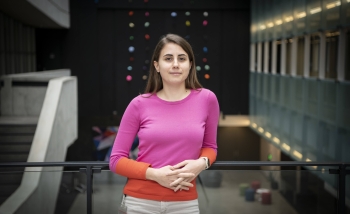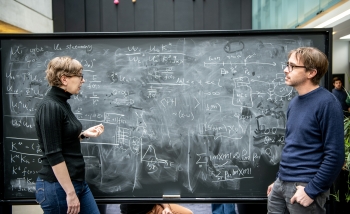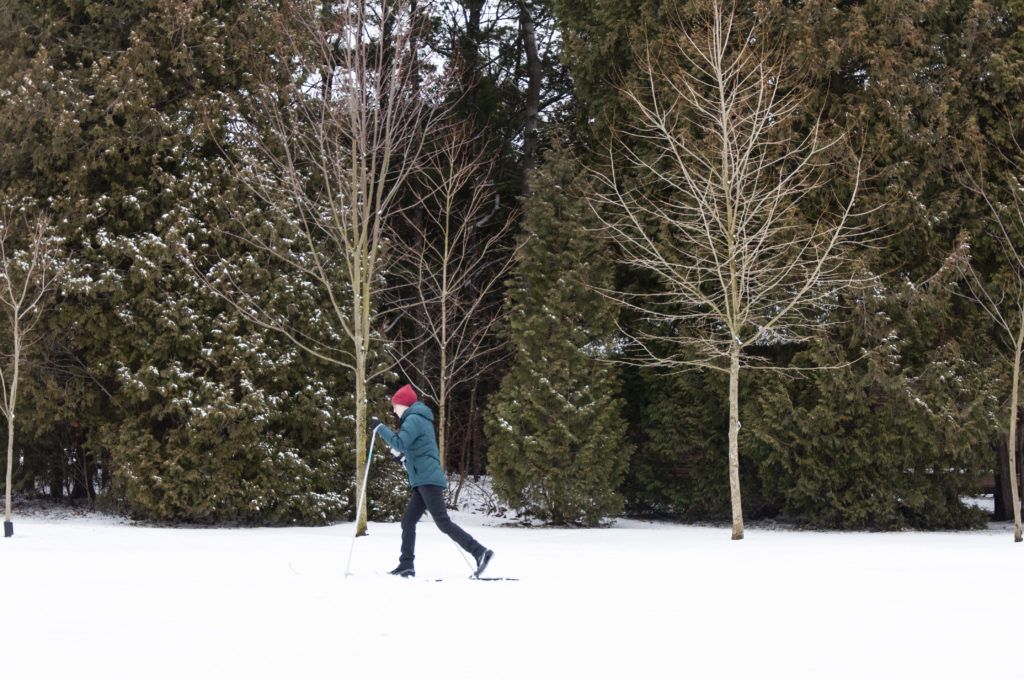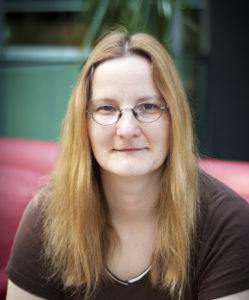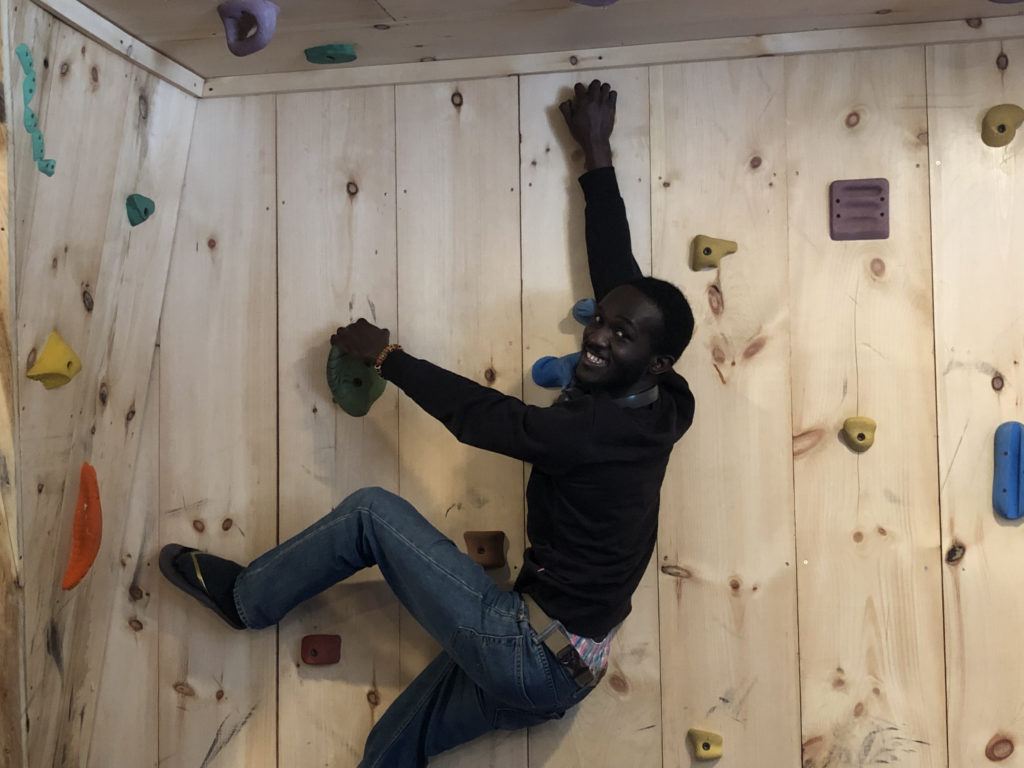In February 2019, Bianca Dittrich had a breakthrough. Specifically, she broke through some ice and got stuck in a crevasse.
The Perimeter Faculty member was on the frozen shores of Lake Huron, where wind and waves pile ice up into shore-fast ridges. She’d left the cozy confines of Perimeter and travelled an hour or two down a rural highway to seek a fresh perspective, at what she calls “a kind of camp for quantum gravity researchers.”
Fortunately, she wasn’t alone, and she didn’t stay stuck in the ice for long.
Equally fortunate, she was about to have a second – less literal – breakthrough. The camp did indeed provide fresh perspectives: a whole new way to approach the quantum gravity tool known as “spin foams.” The new model, which Dittrich and her collaborators dub “effective spin foams,” is a transformative improvement. Calculations that once took weeks on high-performance computing clusters can now be performed in seconds on a laptop.
Now, 18 months on, the researchers are on the edge of being able to conduct the first numerical test of the 30-year-old theory known as loop quantum gravity.
An unsummited peak
Loop quantum gravity is one of the theories that tries to unite quantum theory with our modern theory of gravity. This unification is one of the great unsummited peaks of modern physics. Physicists have been attempting it for generations. Many promising theories have become stuck in the ice on the way up Mount Unification. Some have died there.
Quantum theory says that the universe is – at its most fundamental layer – granular, pixelated: made up of small packets that cannot be broken down further. These are known by the Latin word for packet: “quanta.”
On the other hand, the modern theory of gravity, Einstein’s theory of general relativity, is at its heart a description of spacetime. In particular, it describes the geometry of spacetime as it curves in the presence of mass. Gravity is not a quantum theory: the spacetime it envisions is smooth and stretchy, like a sheet of rubber. It has no granularity, no pixelation.
One way to unite quantum theory with gravity might be to quantize spacetime – to describe its smallest possible piece. That’s the path loop quantum gravity has followed.
Once you have cut spacetime into such minimal chunks, you can start reassembling it. You need to figure out how to glue chunks together, developing an understanding of how they join and interact. Then, you need to run a numerical simulation of how a few – and eventually a lot – of chunks behave.
“Our dream is to simulate a huge spacetime, a huge number of chunks of spacetime,” says Dittrich. “Then we can start to ask questions: How would they assemble? Would it be possible for them to assemble into a Schwarzschild black hole? Could they form gravitational waves?”
In short: Does the re-glued spacetime have the same dynamics predicted by general relativity? Does it look like Einstein when you zoom out?
“OK, so that’s the main question,” says Dittrich. “If we could answer it, we would get 10 Nobel Prizes.”
An impassable pass
Many loop quantum gravity researchers are interested in a structure called a spin foam. In a spin foam, individual chunks of spacetime, described in part by a quantum number called “spin,” stick together like soap bubbles. Spin foams have been around for about 15 years now, and they are fairly well described.
What researchers would like to do next is simulate a spin foam, to describe not just what it looks like, but how it behaves. Running a computer simulation is a first check on whether a spin foam might actually look like the spacetime we’re familiar with if you zoom out far enough.
Modern spin foams – say, those developed in the last decade – are a powerful tool. But they also have a significant drawback: they are too complex to simulate. Each chunk of spacetime is described by a wave function. (A wave function is a mathematical formula used to describe a quantum object.) Before even a single chunk of spacetime can be simulated, its wave function must be solved. Researchers refer to this as “computing the amplitudes.”
“There are many reasons why amplitudes are hard to compute in traditional spin foams,” says Dittrich. But whatever the bottleneck, the bottom line is the same. Calculating the amplitude of a single chunk of spacetime is hard, but doable. Start using multiple chunks to build a spacetime, and the amplitude problem quickly amplifies, becoming too much for even high-performance computers.
The end result, says Dittrich, is that a simulation simply isn’t doable. “An explicit check of the dynamics of these models, even for small chunks of spacetime, has not been achieved yet with these very complicated models.”
Even when an explicit check can be made, there are reasons to worry that it will show problems. Specifically, there are hints that today’s spin foam models don’t allow for gravitational waves. Real spacetime does have gravitational waves, so if spin foams don’t, the whole field is on the wrong track.
One way or the other, it would be good to know.
A new base camp
Which brings us back to the icy shores of Lake Huron.
Dittrich is a believer in taking a step away and examining old questions from new angles, which is why she helped organize the retreat for local researchers in the quantum gravity community. The other organizers were Maïté Dupuis and Sylvain Carrozza of Perimeter and Florian Girelli of the University of Waterloo.
They gathered at Camp Kintail: think ski trails, rock climbing walls, dinners of mac and cheese. There were researchers from local universities and from Perimeter – PhD students, postdocs, and faculty.
“The idea was to have a good mix of people, and also to mix up a bit,” says Dittrich. “We got into working groups and worked on some stuff. I was in one of those groups, and we were working on something weird, called higher gauge theory.”
Also in the working group that day was PhD student Seth Asante, a Ghana native who has since completed his degree and is now the Fields-AIMS-Perimeter Postdoctoral Fellow. (Jointly supported by the Fields Institute for Research in Mathematical Sciences, the African Institute for Mathematical Sciences, and Perimeter, this fellowship supports new PhDs who are African nationals.)
Together, they realized that they could use ideas from higher gauge theory to reformulate spin foams in a way that would make them easier to work with.
Gauge theory is the mathematical language in which those amplitudes are computed. Higher gauge theory is a generalization of gauge theory, which can involve higher dimensions. Moving from gauge theory to higher gauge theory is a little like moving from a map to a globe.
Changing frameworks gave Dittrich and Asante a bird’s-eye view of the amplitude calculation problem. They thought it might be possible to reformulate the description of the spacetime chunks such that the physics remained the same, but the mathematical framework in which the ideas were expressed was easier. It’s akin to (though much more complicated than) reformulating Newton’s laws in terms of momentum rather than mass.
“The idea of the retreat is that you are plucked out of your usual routine and look at something new, so indeed that happened,” says Dittrich. “So then I really had to learn this higher gauge theory. As it turned out, our final model has not much about higher gauge theory there, but that was the starting point.”
The pass opens
Dittrich and Asante returned to Perimeter, joined forces with Hal Haggard, a Bard College faculty member and a Perimeter Visiting Fellow, and spent months on their bird’s-eye reformulation of spin foams. They ended up with a new description of spacetime chunks that had two big advantages.
First, the amplitudes didn’t need to be calculated – they emerged naturally from the description. Second, the way in which the dynamics were encoded in the model was much more transparent. Think again of reformulating Newton’s laws in terms of momentum: it means momentum doesn’t have to be calculated, and it makes momentum transfer much easier to study.
With the easier-to-simulate model in hand, it was time to actually conduct a simulation.
In terms of ease of simulation, their model was a runaway success. “Previous attempts to simulate spin foams require high-performance computers, and take months,” says Dittrich. “We could do simulations for slightly bigger chunks of spacetime on our laptops.”
She corrects herself, acknowledging the fate of graduate students everywhere: “I mean: Seth could do it on his laptop.”
What did the simulation actually show? The team at first suspected that their spin foam model would not reproduce the known dynamics described by general relativity and observed in the real universe around us. (To be a little more precise: no model is yet complete enough to produce such dynamics, but researchers are eager to search for those that look as if they might be heading in that direction, a benchmark they call “semiclassical physics.”)
“We thought we were going to show that maybe spin foams can never achieve this semiclassical limit showing gravitational dynamics,” says Asante. “But we ended up rather showing that, oh, you can actually get good dynamics. So that is nice.”
Nice is understating it. These simulations were the very first to show that loop quantum gravity can reproduce some of the dynamics predicted by general relativity. The first to show that a theory decades in the making actually does what it’s supposed to do: reproduce Einsteinian spacetime when you zoom out.
Scaling up toward the summit
Now that they have found their way out of the literal and metaphorical crevasses, what’s next for the intrepid quantum gravity campers?
Already, the team has shown that the effective spin foam model is governed by a discretized form of Einstein’s equations of general relativity. Seeing familiar equations emerge from a new model is a good sign for those hoping that loop quantum gravity will prove consistent with general relativity.
More recently, Dittrich has taken a slightly different approach and shown that spin foams can create gravitational waves. Since researchers had feared that spin foams could only produce flat dynamics, this too is a surprise and a pleasure.
But what the team – and, indeed, the whole loop quantum gravity community – would really like to do is zoom farther out, moving beyond a small piece of spin foam to something approaching a real spacetime. “The dream is to conduct a simulation for a much larger spacetime – many more building blocks,” says Dittrich. “It will be still a huge challenge to do that.”
“Yes, scaling up is still a difficult problem,” Asante agrees. “Even on a high-performance computer, you still need a large amount of memory and time to do all these computations.”
Nevertheless, this new model – which the researchers call an “effective spin foam” model – is a landmark. Calculations that once took weeks on high-performance computing clusters can now be performed in seconds on a laptop, an improvement of several orders of magnitude.
Thanks to an icy fall, an inspiring camp, and a bird’s-eye insight, quantum gravity models may be coming into computational reach for the first time.
About PI
Perimeter Institute is the world’s largest research hub devoted to theoretical physics. The independent Institute was founded in 1999 to foster breakthroughs in the fundamental understanding of our universe, from the smallest particles to the entire cosmos. Research at Perimeter is motivated by the understanding that fundamental science advances human knowledge and catalyzes innovation, and that today’s theoretical physics is tomorrow’s technology. Located in the Region of Waterloo, the not-for-profit Institute is a unique public-private endeavour, including the Governments of Ontario and Canada, that enables cutting-edge research, trains the next generation of scientific pioneers, and shares the power of physics through award-winning educational outreach and public engagement.
You might be interested in

